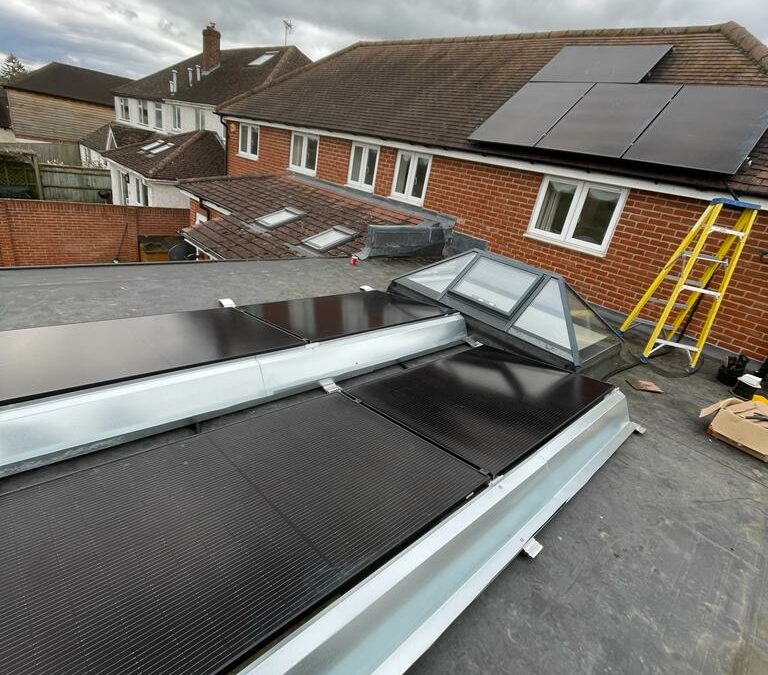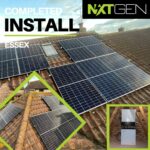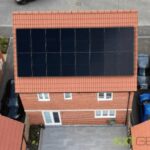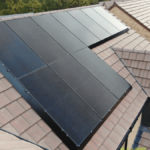Solar Panels on a flat roof are a great way to generate clean and renewable energy from the sun. However, some people think that their flat roofs are not suitable for installing solar panel systems, because they assume that they will need direct sunlight to work. This is a common myth that can prevent many households, businesses and communities from benefiting from solar energy. In fact, solar panels can be installed on flat roofs with the right design and installation methods. Moreover, flat roof solar PV systems can have some advantages over conventional pitch roof solar PV systems in terms of performance, aesthetics and ease of maintenance.
In this article, we will explain how flat roof solar works, what are the benefits and challenges of installing it, and what are the best practices for choosing and installing a flat roof solar PV system for your home or business.
How do solar panel systems on a flat roof work?
The main factor that affects the performance of solar panels is the angle or pitch at which they are installed. Normally solar panels are attached to the existing pitched roof and follow its slope, which may or may not be optimal for capturing the most sunlight throughout the day. Solar panels mounted on a flat roof, on the other hand, allow the MCS Installer to adjust the pitch to suit the location and orientation of the roof. The optimal pitch for a solar panel is about 30 degrees from the horizontal plane, as this maximizes the exposure to the sun’s rays, whilst remaining self-cleaning in the rain.
To achieve this pitch, flat roof solar panels are mounted on brackets that tilt them at the desired angle. The brackets are either placed on tubs that are filled with ballast (such as gravel, paving slabs, bricks, rocks etc) to prevent them from being blown away by strong winds, or fixed on metal frames that are anchored to the flat roof structure. The choice of mounting system depends on the type and condition of the roof structure and its ability to withstand the weight and wind load of the solar panels.
The Pros
- Your home or business will benefit from green, clean, renewable energy and your carbon footprint will be reduced.
- There is more flexibility with the pitch of the solar panels. As a result your MCS Installer can ensure that your panel sits at the right angle to capture the optimum amount of solar energy, whilst remaining self-cleaning in the rain.
- You can choose from a number of different types of solar panels from many different solar brands.
- Installing solar panels onto a flat roof is usually more discrete than having them installed on to a normal pitch roof, and they’re rarely visible from the street
- Flat roofs provide easy access and plenty of room for installation and maintenance of solar panels.
The Cons
- Flat roof systems take up more roof space per kW than solar panel systems on a normal pitched roof. This is because there must be a separation between the rows of the solar panels, in order to prevent one row of solar panels from shading another row.
- Installing solar panels on to a flat roof is dependant on your flat roof structure, as it must be able to handle the additional weight if you are using ballast, which can be a problem.
Installation considerations
How to choose the best pitch for your solar panels on a flat roof?
The pitch or angle of solar panels on a flat roof affects how much sunlight they can absorb and how efficiently they can operate. It also influences how well they can shed dust and dirt that may reduce their performance. To ensure that the solar panels are self-cleaning, they should be installed at a minimum pitch of 10 degrees from the horizontal plane. However, the optimal pitch may vary depending on the location and orientation of the roof and the sun’s position throughout the year. Typically, self-standing solar panels on flat roofs are tilted between 20 and 50 degrees, with 30 degrees normally being the optimal pitch.
At NXTGEN Energy, we are MCS certified installers who can help you find the best pitch for your flat roof solar PV system. We offer free consultations and surveys to design you a solar PV system that suits your needs and your budget. Contact us today to get started by talking to our solar energy experts.
How to protect the solar panels on your flat roof from wind damage?
Solar panels mounted on a flat roof are exposed to strong winds that can damage or dislodge them if they are not properly secured on the roof. There are two main ways to prevent high wind damage to flat roof solar PV systems: fixing or ballasting. Fixing involves attaching a support structure and bracket to the roof itself, which provides a strong and stable base for the solar panels. However, this method may require drilling holes in the roof and may affect the integrity of the flat roof structure. Ballasting involves placing heavy weights, such as ballast tubs, frames and slabs, on the flat roof and mounting the solar panels on them. This method is less invasive and more flexible, but it will add extra weight and load to the flat roof structure.
How to preserve your roof’s warranty with free-standing solar?
Installing a flat roof solar PV system may affect your roof’s warranty, depending on the type of mounting system you choose. Free-standing, ballasted solar PV systems are usually compatible with most roof warranties, as they do not require drilling holes or making alterations to the roof structure. However, fixed solar PV systems may compromise your roof’s warranty, as they involve attaching brackets and supports to the roof itself. Therefore, it is essential that you check your roof’s warranty terms and conditions, as well as its overall condition and suitability, before installing a flat roof solar system. At NXTGEN Energy, we take all of these factors into account when we conduct a free survey of your roof and design a solar PV system that meets your needs and budget.
Can you mount solar thermal panels onto a flat roof?
Anywhere that you can install solar panels, you can also install solar thermal panels.
Do you need planning permission for putting solar panels on a flat roof?
All in all, when it comes down to installing Solar Panels, planning permission is generally not needed. However, if you live in a conservation area or in a listed building we would recommend contacting your Local Planning Authority before going Solar.
You can find further information about planning permission and solar panels on the government’s Planning Portal website.
Thinking About Installing Solar Panels On Your Flat Roof?
If you are a UK business or homeowner considering installing a flat roof solar PV system, get in touch! The solar energy experts here at NXTGEN Energy will be more than happy to help you on your Solar journey. We are also able to discuss alternative types of solar panel mounting, just in case a flat roof solar PV system isn’t suitable for your home! Call us on 01268 928 690 or simply click ‘Enquire Now’ to fill out our short form, to get connected to a Solar Energy Expert.
Frequently Asked Questions About Solar PV On A Flat Roof
You’ll probably need planning permission if you want to put solar panels on to your flat roof. As you know, solar panels on a flat roof are put in frames to provide an angle towards the sun. This usually necessitates a protrusion of more than 0.2 meters above the roof slope, which is normally against the “permitted development” rules.
Solar panels work very effectively on flat roofs, but you’ll need to make sure that you install them with the right mounting equipment to make the system efficient. Although flat roof solar PV systems are more commonly found on commercial buildings, they also work well on domestic properties.
Flat Roof Solar panels are usually mounted onto a tub, and weighed down by ballast (gravel, paving slabs, bricks, rocks etc) in order to resist strong winds. Or alternatively, the panels are mounted onto metal frames. This is usually determined by the roof structure and location.
You will need to allow a border of at least 1m (100cm/40″) around the edges of the roof. The edge zone depends on the roof structure, dimensions and height, and for some systems a border of more than 1m (100cm/40″) will be required.
Yes, as long as the flat roof structure is strong enough to support the panels and their brackets, you can mount solar panels on your garage roof.
Latest Solar Panel Installation Posts
- Why Leisure Centres Should Invest in Solar PanelsIn recent years, the concept of sustainability has become increasingly vital in various industries, including leisure centres. As the global focus shifts towards environmental conservation and renewable energy sources, leisure centres are recognizing the importance of investing in sustainable practices to reduce their operating costs and their carbon footprint. One such sustainable solution gaining traction… Read more: Why Leisure Centres Should Invest in Solar Panels
- Is it worth buying solar panels in Basildon, Essex?☀️ Over 10,000 homes in Basildon have a solar panel system installed. ☀️ You’ll normally break even on solar panels in less than 10 years. ☀️ A 3.5kW solar panel system will cost about £7,000 on average. Solar panels are becoming more affordable and more common in the UK, with over 1.3 million households already… Read more: Is it worth buying solar panels in Basildon, Essex?
- Unveiling the Perfect Fit: How Many Solar Panels Can Your Roof Handle?Harnessing the power of the sun is an attractive proposition for many UK homeowners. But before diving headfirst into solar energy, a crucial question arises: how many solar panels can fit on your roof? The answer, unfortunately, isn’t a simple one. It’s a captivating interplay between several factors, each one requiring careful consideration. Understanding Your… Read more: Unveiling the Perfect Fit: How Many Solar Panels Can Your Roof Handle?
- Powering Care with Sunshine: How Solar Panels Benefit Nursing HomesNursing homes are the backbone of our communities, providing essential care for our elderly population. But keeping these facilities running smoothly requires a significant amount of energy – lighting, heating, cooling and medical equipment all contribute to a hefty energy bill. This is where commercial solar panels come in, offering a win-win solution for both… Read more: Powering Care with Sunshine: How Solar Panels Benefit Nursing Homes
- Who are NXTGEN Energy Ltd?NXTGEN Energy Ltd are a solar energy company based in Rayleigh, Essex, UK. They specialize in the installation of solar panels, battery storage systems, and electric vehicle chargers for homes and businesses across the UK. They are MCS certified, which means they meet the Microgeneration Certification Scheme’s standards for quality and safety. This makes them… Read more: Who are NXTGEN Energy Ltd?
- Why UK Homeowners with Solar Panels Need Bird Proofing (Beyond the Basics)Imagine waking up to the quiet hum of your solar panels, generating clean energy to power your home. It’s a beautiful image, symbolizing lower electricity bills and sustainability. But what if a gang of birds decided the solar panels on your roof were the perfect spot for their new condo complex? Unfortunately, this idyllic scene… Read more: Why UK Homeowners with Solar Panels Need Bird Proofing (Beyond the Basics)







